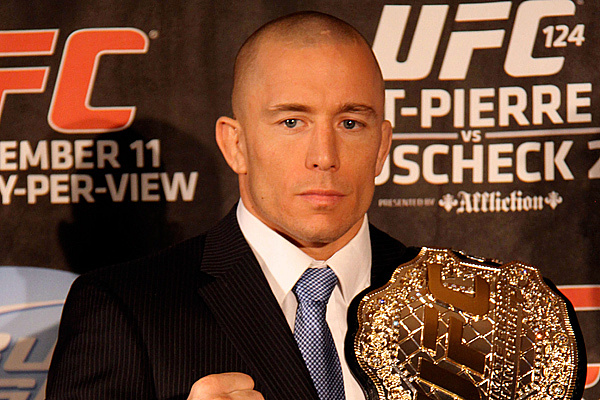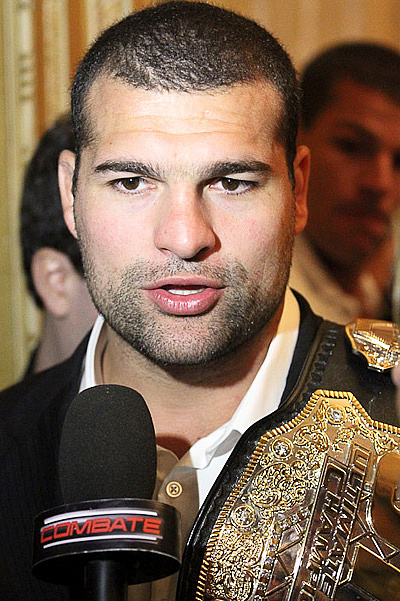Storylines That Emerged from UFC 126
Jason Probst Feb 7, 2011

Anderson Silva vs. Georges St. Pierre (above) would draw vast
public interest. | Stephen Fernandez/Splash News
With Anderson Silva and Jon Jones playing leading-man roles at UFC 126, the fight world was treated to a memorable and truly important event. Below, a look at the storylines that emerged from Saturday night’s action.
Silva-GSP Looms, Like It or Not
Advertisement
At the UFC 126 postfight press conference, Dana White addressed the long-running issue of a super-fight between Silva and welterweight king Georges St. Pierre. The UFC president said that the bout is likely to happen should St. Pierre defeat challenger Jake Shields at UFC 129 on April 30.
If St. Pierre does win, particularly in the Secretariat-like
fashion he’s shown of late, a match with Silva seems obvious. Both
will have cleaned out their respective divisions for the most part,
particularly St. Pierre, whose stable of challengers consists of
guys he has already dominated. St. Pierre-Silva would hardly be
fair to top welters like Shields, Jon Fitch,
Thiago
Alves or B.J. Penn
(should he defeat Fitch later this month), but public perception
shapes matchmaking decisions.
The thing is this: St. Pierre should not be moving up to middleweight, especially when he doesn’t have to from a biological standpoint. He walks around at a solid 190-195 pounds and makes the cut to 170 like clockwork, retaining his natural size and strength advantage. Combined with his superior athleticism, it makes him virtually the perfect welterweight.
True middleweights such as Silva walk around north of 210 pounds. To add the proper weight, St. Pierre would really be pushing his biological envelope, and it’s this writer’s opinion that it would be a dubious transition if done in the timeline required for Silva-GSP -- most likely, late 2011 -- as opposed to filling out naturally over a longer stretch. The latter option could take 3-4 years and still pose problems, as GSP is simply not a natural 185-pounder.
As boxer Michael Spinks showed in 1985 when he moved from 175 to 210 pounds to defeat Larry Holmes, only to later be crushed in 91 seconds by Mike Tyson, it doesn’t matter how many reps a guy has done in the gym when he’s being hit by a bigger man who was naturally larger to begin with.
Greatness comes to those who dare to be great, and GSP certainly has the wrestling and explosiveness to give Silva some problems. But part of me recoils at the idea of him risking a terrible beating merely to satisfy fans who have become bored with a dominant title run. St. Pierre is on the short list of the game’s most marketable fighters, and he owes no debt to the middleweight division.
To GSP’s credit, he’ll probably accept the challenge. However, if he adds weight by simply bulking up as he has indicated and loses to Silva, it’s going to be that much harder to return to 170. St. Pierre-Silva is a tremendous and eminently marketable fight, but one for which St. Pierre should be paid handsomely, because taking on “The Spider” would be going above and beyond the call of duty.
‘Bones’ Jones Shows Mojo, a la GSP and B.J.

Mauricio
"Shogun" Rua File Photo
"Shogun" will put his title on the
line against Jon Jones at UFC 128.
What’s interesting is that, while both St. Pierre and Penn reached the rarified air of the emerging superstar, they each lost their first chance at UFC gold. St. Pierre was looking impressive in his initial meeting with champ Matt Hughes, but a mental mistake in the waning seconds of the first round cost him an armbar submission loss. Penn, a 3-1 favorite over then-champ Jens Pulver, succumbed to the rigors of a five-round bout.
Both Octagon greats rebounded from those experiences. If Jones beats a talented champ like Rua at 23, several years before his ostensible prime, odds are good that he won’t lose for a while.
Rua’s leg kicks and wealth of experience, especially in long fights, are the big advantages he’ll take into the match. But the funny thing about Jones is that he continually sails over the bars set for him, even against supposed tough tests like Brandon Vera, Matt Hamill, or Bader.
The Rua bout will be Jones’ ultimate proving ground and Bones’ performance Saturday night guaranteed that the world will be watching. Given their current trajectories, the biggest fight of 2012 could be Jon Jones vs. Anderson Silva.
The Curse of Japan Continues with ‘Kid’
Heading into his bout with Demetrious Johnson, Norifumi “Kid” Yamamoto was a slight -115 favorite at the sports books. Given Kid’s edge in experience, it seemed a bit low, but betting lines are a nebulous mix of public sentiment, perception, and insiders constantly striving to play off those two. It turns out they were right, as Yamamoto was outworked by Johnson over 15 minutes, dropping a unanimous decision in his Octagon debut.
With considerable mileage on his body, the 33-year-old Yamamoto’s best days are likely behind him. His tough debut mirrored those of other top fighters from Japan who floundered in their transitions stateside, including “Shogun” Rua, Takanori Gomi and Mark Hunt.
Layoffs, ring rust and various injuries have played roles in those losses, and there’s the fact that Johnson is a pretty good fighter himself. But, at this point, it’s clear that coming from overseas with a big name is anything but a lock when trying to make it in the UFC.
Glove-Touch Etiquette Needs Clarification
Fighters aren’t required to touch gloves at the start a bout, but it does provide a nice tradition of sportsmanship to kick off a contest. There’s always an interesting interplay with the fighters’ prefight eye contact, and most of the time, touching gloves goes off without a hitch.
In the lightweight bout between Donald Cerrone and Paul Kelly on Saturday, Kelly violated that sense of sportsmanship by touching gloves and then immediately heaving an overhand right. Thankfully, Cerrone’s reflexes allowed him to duck the shot, and he submitted Kelly in the second round. To Cerrone’s credit, he didn’t complain about the move afterward, even when Kelly interrupted his postfight interview to issue a cheap apology that he was “just going to work” with the punch.
What if Kelly’s punch had landed, stunning Cerrone or even knocking him out? Everyone involved would have had a mess on their hands. Since touching gloves is optional, this is more of an ethical breach than a rules infraction, albeit one with potential for extreme ugliness.
There’s an obvious body language fighters undertake when touching gloves. They extend their lead hands and walk to the opposite side, essentially making it impossible to land a clean (i.e. not cheap) strike. If Cerrone extended his glove and Kelly planned on punching him, he shouldn’t have touched gloves simply to get himself within firing range.
This was a near-miss and will be lost to the sands of time, but just imagine if it had happened in the main event and ended the fight 10 seconds in. Guys who touch gloves and then go berserk need to be in another sport, or they need to make it eminently clear before the fight starts that they have no interest in doing it.
Griffin, Ellenberger Show Value of Game Planning
Forrest Griffin and Jake Ellenberger demonstrated tactical smarts in their respective bouts, watching the clock while timing takedowns to win key rounds. Against Rich Franklin, Griffin hit a key takedown at the end of the third round to seal three 29-28 scorecards from the judges. Ellenberger, meanwhile, used the clock intelligently as well.
After a tough first round in which Carlos Eduardo Rocha unleashed a flurry of submission attempts, Ellenberger steered clear of the Brazilian’s dangerous guard, except to hit key takedowns at the end of the second and third rounds. It’s one thing to dive into a tricky guard; it’s a much lesser risk to do so with 30 seconds or less to go in a round.
Broken down into its disparate parts, a three-round fight is exactly that -- three separate fights, of which a fighter must win two in order to emerge victorious. Clock awareness is a big factor in fights, and both Griffin and Ellenberger showed solid time management skills in taking hard-earned decision wins.
Reader comments are active below. Register an opinion by signing in with your Facebook, Twitter, Google or Yahoo! account.
Related Articles







